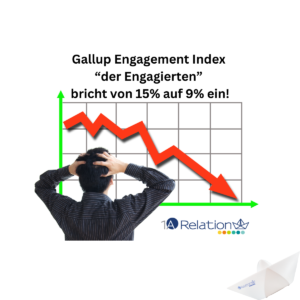At the start of a new year, it’s a good idea to ask yourself, “What do I expect in the MarTech technology space in 2023? What technologies will continue to engage the MarTech world in the coming year, again and all over again?” That’s why we selected 7 MarTech predictions for 2023 for you.
We try to forecast these questions below. And this based on a wide variety of impressions from consulting projects, our exchange with software vendors and our own research from 2022.
In this article, we look together at our trend predictions:
- AI and chatbots
- Personalized video content
- Contextual targeting in cookie-free browsers
- Social selling
- The Metaverse
- Voice synthesis
- No-code and low-code
But beware: Unlike many others, we think that every company has to think about these topics individually. Of course, we are happy to help.

#1 AI and the chatbot
Customers increasingly see brands as an “entity” with which they can have a real conversation, whether through social media engagement or chatbots.
Users increasingly want to interact directly with the brands they love. It doesn’t matter if it’s support, praise or criticism.
This was particularly evident during the Corona pandemic, when the volume of interactions with enterprise chat platforms increased by as much as 250% across many industries.[1]
We predict that conversational marketing will capitalize on this trend and provide users with the interaction experience they desire. A big part of this will be opening up new ways to communicate with customers, especially through messaging services like WhatsApp.
It’s also important to watch how intelligent chatbots like ChatGPT, which are experiencing a lot of hype right now, develop. Major tech giants have already picked up on this development and are planning to incorporate intelligent chatbots into their products. Microsoft, for example, plans to make ChatGPT available in its Office solutions.
#2 Personalized video content will continue to grow in importance
Another important development is the use of video content in marketing. As early as 2022, 82% of all online activities contained some form of video content. 96% of consumers watch explainer videos before buying a product, for example, and advertisers are finding that video ads drive significantly higher click-through rates compared to static ads.[2]
However, there’s a catch: over 80% of all “skippable” videos are skipped. Especially those that are longer than 15 seconds.[3] For this reason, the focus should be on achieving a higher video conversion rate, not just a large number of views.
As a result, we predict that short-form personalized video ads will be a major marketing trend in 2023. Users are more likely to engage with content that is less than 15 seconds long. It’s a thesis that is quickly supported when you consider the success of TikTok and Instagram Reels – the most successful of these short videos rarely have a significantly longer runtime.
Personalizing video ads for a target audience increases completion rates by an average of 85%. This means that solutions like personalized video marketing tools, need to dynamically select and display content based on user preferences to help brands engage users with video content. The extent to which positive examples in B2B allow a fundamental statement on this is to be verified in 2023.
#3 Contextual targeting will become an increasingly important strategy
The “cookie-free” future is approaching with ever greater strides – but it is not yet clear when this will be the case. According to Google, the target is Q2 2024. From then on, there will be no more 3rd party cookies in Google Chrome. The result? Around 60% of global web traffic will be cookie-free as a result.[4]
This means that brands will have to look for new, privacy-friendly ways to reach users and gain information about them.
In doing so, many are not reinventing the wheel, but instead are reverting to a long-known technique – contextual targeting.
New technology like AI and deep learning makes it easier than ever for users to predict what content a website visitor will want to engage with.
#4 Social Selling
Social selling – creating a buying experience for customers directly via their favorite social media app – is becoming increasingly popular. Social selling extends to all social media platforms, whether Facebook, TikTok, LinkedIn or Pinterest. Social selling has arrived in 2022 – in Germany, 42% of all online shoppers have already made a purchase via social media at some point.[5]
The great advantage of social selling is the integration of all sales channels in one place. Advertising, information gathering about a product, the buying process and check-out all take place in a social media app.
We therefore predict that eCommerce will be increasingly interwoven with social media applications in 2023. However, it is important to note that social selling only works if a brand builds strong and sustainable customer relationships. Social selling is thus not just a trend to try out. Social selling is strongly interwoven with the branding of a company and is therefore much more a part of the future strategy.
#5 Metaverse – (AR and VR provide momentum)
In its Hype Cycle for technologies[6], Gartner names metaverses as one of 25 technologies to know.
For Gartner, a metaverse is a “collective, virtual, shared 3D space created by the convergence, of virtually augmented physical and digital reality. A metaverse is persistent and provides enhanced immersive experiences.”
Gartner expects metaverses to be accessible across devices and not controlled by a single vendor.
“Metaverses will offer up their own virtual economies in which digital currencies and non-fungible tokens (NFTs) play a key role.” Gartner predicts that by 2027, more than 40 percent of all companies will offer “digital twins” of their products in one of the metaverse.
The path to the metaverse is particularly primed by the use of virtual reality (VR) and augmented reality (AR). For example, Snapchat, a subsidiary of Meta Group, is a pioneer in this field and provided AR lenses for its user for the recent blockbuster movie “Avatar” and the past World Cup.
Therefore, we predict that the journey into the metaverse is still in its infancy, but VR and AR will help create a stronger experience with a brand that engages customers.
#6 Voice synthesis
The future of voice synthesis lies in AI. Everyone is familiar with the unpleasantly distorted computer-generated voices for telephone announcements or in old navigation devices. An improvement in this has been underway for several years and has been particularly rapid in the last 12 months.
This is evident in a pilot project by RTL and Microsoft to synthesize voices. The voices produced now sound more natural than ever before.
The technology is based on a deep learning algorithm that learns from given audio material. This makes the synthesis more and more realistic and lifelike. The result is a voice that sounds so natural you almost want to believe it’s a human. In the process, only several hours of material were needed to train the AI.
In the future, we predict that such tools will play an important role in the creation of personalized media offerings. In the media world, synthesized voices can also give journalists or audio speakers, for example, more time for research instead of standing in the recording box.
#7 An old acquaintance remains – No Code and Low Code
In recent years, a new trend has emerged for the development and customizing of software: Low Code and No Code programming.
This trend enables users to implement their ideas and wishes more quickly by using prefabricated software components. For example, drag-and-drop functions make it easier to customize a user interface or a website according to one’s own wishes. As a result, software projects can be realized in a shorter time and do not have to resort to complex code-based solutions, for which skilled personnel are currently hard to come by.
However, low code and no code is not for everyone. Profound and specific changes to a software still require software developers. Especially in order to build up their own know-how of the tools used in the long term.
One conclusion: watch out for trends – not all that glitters is gold
When it comes to trends, there is one thing that remains important for us to emphasize:
Trends don’t lie in the cellar or wait to be kissed awake at the turn of the year.
MarTech trends are not like potatoes lying in the cellar waiting to be processed. Unlike the aforementioned potato, trends do not come with a “guarantee of success” or “recipes” for implementation.
Trends are much more complex and have to be evaluated individually for each user, and they develop over a longer period of time. Over these periods, trends can develop a different pace due to technical breakthroughs, a momentum of their own or a media bubble.
A practical example of this is the topic of AI. This in itself has been known as a concept for a long time. However, there are always new hypes around individual facets of AI, such as recently around ChatGPT, a dialog system based on AI.
The technology behind ChatGPT is both ingenious and fascinating. Some questions (e.g. copyright) are still unresolved. However, one thing is clear: the benefits of this technology are different for each company. Therefore, each company must ask itself whether this technology suits it and whether the necessary foundations have been created in its own company to successfully implement such a trend in its own company.
If you have any questions about the above-mentioned possibilities, we cordially invite you to a discussion.
[1] https://financesonline.com/live-chat-software-statistics/
[2] https://www.tubefilter.com/2013/06/10/skippable-online-video-ads-percentage-completion-rate/
[3] https://blog.hubspot.com/marketing/state-of-video-marketing-new-data
[4] https://gumgum.com/blog/the-cookieless-future
[5] https://www.beyond-print.de/trends-auf-social-selling-folgt-social-commerce-aber-was-ist-das-eigentlich/
[6] https://www.gartner.de/de/artikel/was-ist-neu-im-hype-cycle-2022-von-gartner-fuer-neue-technologien
Note: This is a machine translation. It is neither 100% complete or 100% correct. We can therefore not guarantee the result.












